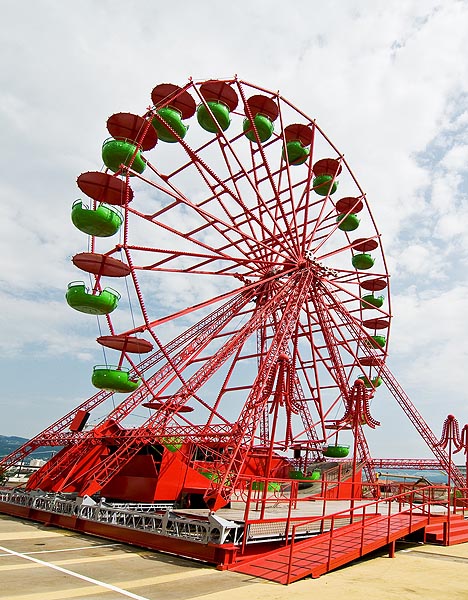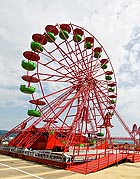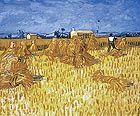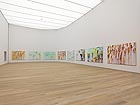
translated and summarized by: Liz Wollner-Grandville,
English summary July 6 - 12
O.K. offenes Kulturhaus Oberösterreich: OK-Höhenrausch
Freedom beneath the clouds
At times it gets drafty. Thrown, seated or positioned into the notorious rain in Linz. And windy, gusting over 50 km/h. And then again: at the mercy of the relentlessly burning sun at maximum height over the sunny urban canyons. Where the onlooker mutates into a roof vagabond on the city’s sundeck bathed in light and air.
The “Höhenrausch” exhibition (high altitude euphoria) is a typical case of outdoor-extravaganza, which so far has attracted more than 50.000 visitors and is the most popular exhibit of the Linz09 event. The view includes the neighbourhood: the nearly completely burned down Ursulinenhof, the flat roofs of the Passage City Centre and the huge garage. Beneath the clouds, where freedom (of art?) is limitless.
“Höhenrausch”, the final act of the trilogy “Art into the City!” explores and reveals the panorama of the roof landscapes of Linz in seven stations, the former “steel city” between Pöstlingberg and the VOEST-factory as a consumer friendly and folk festival-like installation with its urge towards entirety. After all: the city itself, and how it is perceived from above even by its resident tourists and without googling, is the actual star of the show.
Among the works shown are Erwin Wurm’s conversation piece “Tell”, the laconic-absurd slapstick film by Roman Signerm, Og D’Souza as an overhead skater on his breathless hunt through the tilted breadths of the Sao Paulo Biennial (Shaun Gladwell), and Shih-Yung Ku’s kaleidoscopic fragmentation of the panoptical view.
Co-starring: the signage and navigation system of the “Atelier Bow-Wow” – a huge and overpowering “branch”, a walk-in sculpture with a few daredevil overhangs offering extravagant views, imposed over the “Cultural Quarter Linz”; a wooden work of wonders - with catwalks and platforms and a “Ladder to Heaven”.
Only topped by Linz09’s new testimonial: Maider López’ “High Wheel”.
By Stephan Maier
O.K. offenes Kulturhaus Oberösterreich
4020 Linz, Dametzstrasse 30, until 13.09.09
www.ok-centrum.at
Kunstmuseum Basel: Vincent van Gogh – Between Earth and Heaven: The Landscapes
Rewarding abundance
Following last year’s van Gogh exhibition in Vienna - in which his paintings were set in contrast to his drawings - the Kunstmuseum Basel is now displaying another extensive exhibition of works by this artist, of whom many assume to already have seen everything. Nevertheless, it is rewarding to travel to Basel. According to Bernhard Mendes Bürgi, the director of the museum, the exhibition centres its attention on a new view of van Gogh’s landscapes and not on the legend enveloping the artist. The 70 landscape paintings presented in chronological order from 1883 to 1890, encompass all of his creative phases and stages of life. In one of the numerous letters to his brother Theo, he writes: “I am ploughing in my paintings (….), like the farmers on their fields.” Among the paintings, which were contributed by more than 50 collectors worldwide, are well-known works such as “Cypresses” (Metropolitan Museum of Art, New York) or the “Wheat Fields with Sheaves” (Honolulu Academy of Arts) as well as numerous works from private collections, which so far have rarely been exhibited. Van Gogh’s landscapes will most probably not be displayed again in this form and abundance in the near future. The exhibition unveils the inner tension, the pulsating excitement which constantly accompanied the artist and which he brought forward with his brush and paints. Landscapes not simply “copied” by van Gogh, but quasi re-created by his visionary view. The continuity of his search and the transformation of his works only become apparent by comparing the abundance of his variations. Over time, the dark, earthy and hazy tones were replaced by light, bright and contrasting tones. The presentation is accompanied by an exhibition of 40 landscape paintings of the Kunstmuseum Basel’s collection ranging from Claude Monet, Paul Signac, August Renoir, Paul Gauguin, and Paul Cezanne to Henri Matisse.
Murielle Schlup Theocharis
Kunstmuseum Basel
4010 Basel, St. Alban-Graben 16, until 27.09.09
www.kunstmuseumbasel.ch
Kunstareal München - Museum Brandhorst
In the wellness oasis of art
In his novel “Gladius Dei” Thomas Mann describes Munich’s cultural climate around 1900 as “blooming” and “dominating”. But what about today, in a time in which the Bavarian TV channel readily sacrifices its afternoon program for the opening of a museum?
A brandnew Pinakothek of the fourth dimension pointing towards the future? Does the “System of Optimism” allow us to forget about the long overdue second building stage of the Pinakothek der Moderne? Because for the most part, the “Collection Brandhorst” is publicly a more protected than supported private museum, financed by the state of Bavaria: 48 million euros for the construction plus maintenance and personnel costs.
The Udo and Anette Brandhorst Foundation (with its capital contribution of 120 million euros) offers the museum an annual buying budget of 2 million euros, while the spending money of the neighbouring Pinakothek museums only amounts to meek 65.000 euros. And as the new director Klaus Schrenk points out: the buildings not only “stand in opposition” to one another regarding their location…
The collection comprises 700 works of the 20th and 21st century, among others by Cy Twombly, Andy Warhol, Joseph Beuys, Mario Merz, Jannis Kounellis, Sigmar Polke, Georg Baselitz, and Gerhard Richter. The estimated value of Brandhorst Collection is 100 million euros. The selection of the works, however, has more to do with the personal taste of the collectors than showing any commitment to a scientific basis or the principle of completeness.
The building, which emanates a kind of “Missoni-chic, is designed by the architects Sauerbruch Hutton, and offers three floors of what can be described as a rather trendy exhibition space covering 3.200 square meters; an ecologically valuable wellness oasis of art.
By Stephan Maier
Kunstareal München – Museum Brandhorst
80333 Munich, Theresienstrasse 35a
www.museum-brandhorst.de
expositur: The Essence 2009
Transgressing boundaries
The Essence is the descriptive title of the annual exhibition of the University for Applied Arts in Vienna, shown at the new venue: the expositur. Selections of individual and group works, all created last year, are presented. The manifold facets of the courses taught at the University of Applied Arts are displayed with works and projects in the fields of architecture, industrial design, fine arts, stage design, media design and restoration, and offer an extensive and diverse overview.
Architecture is taught at three studios – each with a different main theme, displayed next to one another, concentrating on the duplicability of the developmental process. The Studio Prix, for example, is involved with a new type of skyscraper, which produces more energy than it consumes in its household.
At the Institute for Industrial Design Fritjof Giese designed a life vest, which, despite being inconspicuous and very comfortable, ensures a simple handling and reliable safety aspects. Equally as elegant as the design is the aesthetic photographic depiction of the vest’s functionality. And the form of Patrycja Domanska’s “Sono Love” is similarly appealing. One could almost describe this sex toy for women, which is extremely versatile and individually applicable, as being beautiful.
“Partying until the physician arrives” is the title of Sebastion Vonderau’s light installation. 49 neon lights are equipped with weak starters and without a plastic cover, inducing that each individual starter turns purple in an irregular rhythm during its incessant attempt to light up the lamp and the tube radiates white flashes. The light sculpture beams in an odd pattern. After a few days the starter exerts itself, and the lights go out. The work is a poetic ode to the waste of personal substance to attain reckless liveliness; this possibly being a metaphor for creative processes.
With his “Techno Taktil”, Stefan Fahrngruber’s developed an instrument that enables to translate digital surfaces into impulses - based on their light intensity. In turn, by placing one’s finger on an area of 12 x 15 mm one senses these impulses. Fahrngruber created an alternative perception of digital content – a creation enabling visionary dimensions.
The Essence shows the vast variety of expressive forms of art, and once again proves that definitions of boundaries and disciplines in art hardly have any validity; on the contrary – their transgression and linkage offers a creative potential.
By Margareta Sandhofer
expositur
1030 Vienna, Vordere Zollamtstrasse 3, until 15.07.09
www.digitalekunst.ac.at
Mehr Texte von translated and summarized by: Liz Wollner-Grandville


 Teilen
Teilen





